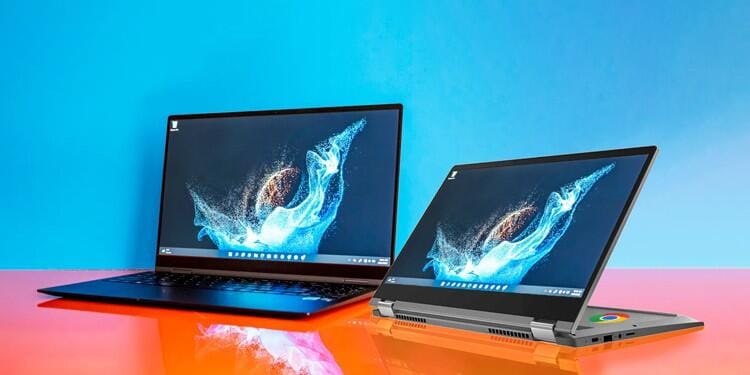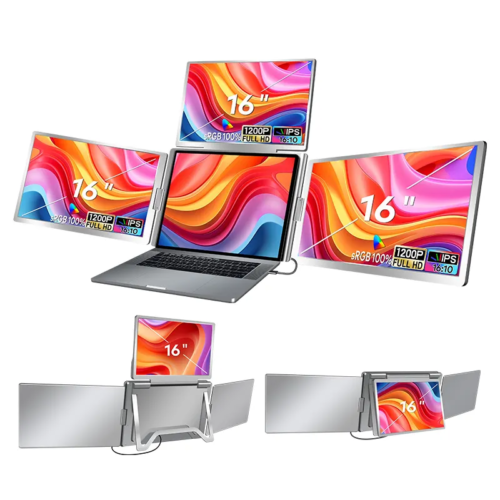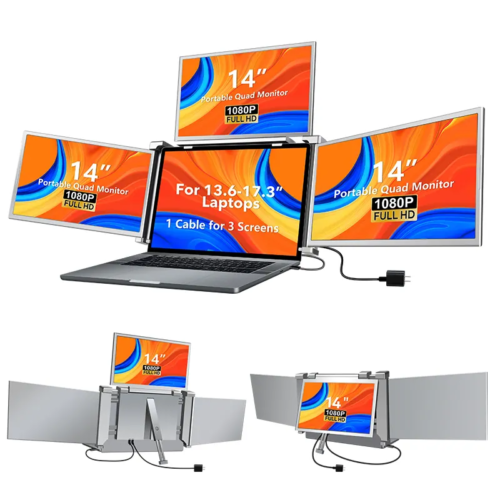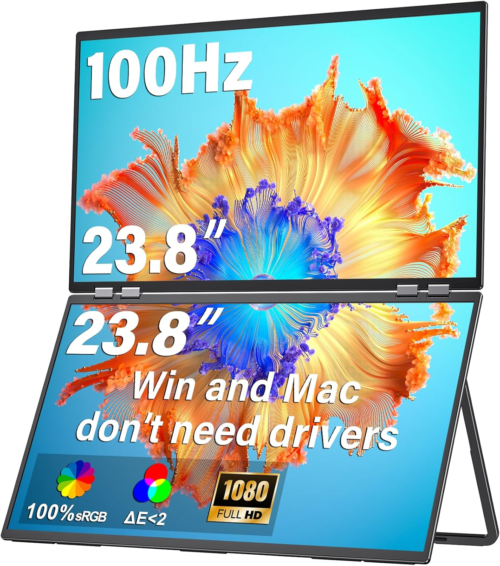Chromebooks have steadily grown in popularity due to their simplicity, affordability, and seamless integration with Google’s ecosystem. For users looking to enhance their productivity, learning how to use the split screen feature on a Chromebook can be incredibly useful. Moreover, many users are increasingly exploring the idea of using their Chromebook as a second monitor for laptop, maximizing multitasking and work efficiency. In this blog, we will delve into various techniques for utilizing the split screen on a Chromebook, the benefits of pairing it with a second monitor, and how to solve practical challenges.
From basic split screen functionality to connecting your Chromebook to a second monitor for laptop, this guide will cover every detail to help you leverage this powerful tool.

1. Basic Split Screen Guide on Chromebook
Using the split screen feature on a Chromebook can drastically improve how you manage multiple tasks at once. This functionality allows you to view two windows side by side, making it easier to work on different applications simultaneously.
How to Activate Split Screen:
- Drag Windows: The easiest way to initiate split screen mode is by dragging a window to the left or right edge of the screen. The window will automatically snap to take up half of the display.
- Keyboard Shortcuts: Alternatively, use the shortcuts “Alt + [ ” or “Alt + ]” to quickly move windows to either side of the screen.
Practical Uses of Split Screen on a Chromebook:
- Writing a document while referencing another webpage.
- Editing a Google Sheet while reviewing related emails.
- Managing your social media accounts side by side.
These capabilities are not just for casual use—they are essential for anyone seeking to multitask effectively. By mastering the split screen feature, users can improve workflow efficiency and streamline digital tasks.
2. Using Chromebook as a Second Monitor for Laptop: Enhancing Multitasking Capabilities
For many professionals, the need for additional screen space becomes apparent as tasks pile up. Fortunately, your Chromebook can double as a second monitor for your laptop, giving you expanded workspace. This capability transforms your Chromebook into a portable second screen that offers flexibility for both remote work and travel.
How to Use Chromebook as a Second Monitor for Laptop:
While Chromebooks don’t natively support dual monitor setups, third-party applications like Duet Display or Spacedesk offer a workaround. These apps enable wireless screen extension, allowing users to utilize their Chromebook’s display as an additional screen.
Steps to Set Up a Chromebook as a Second Monitor:
- Install Third-Party App: Download and install Duet Display or Spacedesk on both your laptop and Chromebook.
- Connect Devices: Use Wi-Fi or USB cable to connect your laptop and Chromebook.
- Extend Display: Configure your laptop to extend the display to the Chromebook, effectively turning it into a second monitor.
This setup is perfect for users who want to expand their screen real estate without purchasing a dedicated external monitor. It is also highly beneficial for those who work from different locations or need flexible workspace solutions. Whether you’re working on a large project or juggling multiple programs, using your Chromebook as a second monitor for your laptop offers increased productivity.
Benefits of a Second Monitor Setup:
- Increased Efficiency: Having two screens allows you to focus on multiple tasks at once, reducing the need to constantly switch between tabs and windows.
- Seamless Workflow: You can dedicate one screen for communication (email, chat apps) and another for your main work (editing documents, coding, or designing).
- Cost-Effective: Using a Chromebook as a second monitor is a budget-friendly alternative to buying a dedicated external display.
3. Connecting Chromebook to an External Monitor
In addition to serving as a second monitor, Chromebooks can also connect to external displays to provide even more screen space. This feature is ideal for users who need a larger display for presentations, media editing, or simply more visibility.
How to Connect Chromebook to an External Monitor:
- Use USB-C or HDMI Ports: Most Chromebooks come with either a USB-C or HDMI port, which can be used to connect the device to an external monitor.
- Mirror or Extend Display: Once connected, you can choose to either mirror your Chromebook’s screen on the monitor or extend the display to create more workspace.
Key Considerations:
- Resolution Compatibility: Ensure the external monitor’s resolution is compatible with your Chromebook to avoid display issues.
- Port Types: Check if your Chromebook requires adapters (such as USB-C to HDMI) for certain monitors.
Using an external monitor with a Chromebook allows users to work more efficiently by having access to a larger screen while keeping the portability and simplicity of a Chromebook.

4. Optimizing the Chromebook Split Screen Experience
While the split screen feature is straightforward, optimizing the experience can make it even more effective for daily use. Here are several tips to help maximize your productivity when working with a split screen setup:
Tips for Enhanced Split Screen Functionality:
- Adjust Window Sizes: Chromebooks allow users to manually resize windows by dragging the center divider. This is useful when one task requires more screen space than the other.
- Virtual Desktops: Chromebooks support virtual desktops, which enable you to switch between multiple workspaces. This can be an excellent complement to split screens, especially when managing multiple projects.
- Touch Screen Features: If your Chromebook has a touch screen, use gestures to switch between applications and manage windows quickly.
- Keyboard Shortcuts: Learning shortcuts such as “Alt + Tab” to toggle between applications can significantly speed up your workflow.
These features make Chromebook an incredibly versatile tool for users who need to juggle multiple tasks simultaneously. By mastering the split screen and optimizing the setup, you can create a more organized and productive workspace.
5. Chromebook as a Second Monitor for Laptop: Challenges and Solutions
While using a Chromebook as a second monitor for a laptop offers various benefits, there can be some challenges. Below, we outline common issues and provide troubleshooting solutions.
Common Issues When Using Chromebook as a Second Monitor for laptop:
- Display Lag: Wireless connections may cause display delays, especially during high-data activities like video editing or gaming.
- Connection Problems: Users may face difficulty establishing a stable connection between the Chromebook and the laptop.
- Battery Drain: Running two devices simultaneously can lead to faster battery drain on both devices.
Solutions to Overcome These Challenges:
- Use USB Connection: Whenever possible, use a wired connection (such as a USB-C cable) to reduce display lag.
- Optimize Network Connection: Ensure both devices are connected to a stable Wi-Fi network, or consider using a dedicated router for the best results.
- Monitor Battery Usage: Keep your Chromebook and laptop plugged in when using them for extended periods to avoid draining the battery.
By addressing these challenges proactively, you can make the most of your Chromebook as a second monitor without interruptions.
6. Economic Display Options for Chromebook as a Second Monitor for Laptop
For those who prefer a dedicated external monitor over using a Chromebook as a second monitor, selecting a budget-friendly option is crucial. Chromebooks pair well with a wide range of monitors, but finding the right one can be a bit tricky. Below, we provide recommendations for economic monitors that can serve as ideal second displays for a laptop or Chromebook.
Factors to Consider When Choosing a Second Monitor for Laptop Chromebook:
- Resolution: A monitor with a 1080p or 1440p resolution is usually sufficient for most tasks.
- Port Availability: Make sure the monitor has the necessary ports (USB-C, HDMI) that match your Chromebook.
- Price: Look for monitors that offer the best value for money, with prices ranging between $100 and $300.
Recommended Budget Monitors:
- Acer R240HY: A 24-inch Full HD display with excellent color accuracy and wide viewing angles. Perfect for users looking for a balance between performance and affordability.
- ASUS VA24EHE: A 24-inch monitor with a 75Hz refresh rate and adaptive sync technology. Ideal for both work and casual gaming.
- ONext24 FHD Monitor: A budget-friendly monitor with built-in speakers and an ergonomic stand, making it a versatile option for home and office setups.
By choosing an affordable yet reliable monitor, users can greatly enhance their Chromebook’s functionality without spending too much.

7. Future Trends and Innovations in Chromebook and Monitor Technology
The world of Chromebooks and external monitors continues to evolve with exciting new developments. Here’s a look at what the future might hold:
Higher Resolutions and Display Quality:
- As display technology advances, users can expect to see more Chromebooks and external monitors with 4K and even 8K resolutions, providing crisper visuals for everything from media consumption to professional work.
Enhanced Connectivity:
- New developments in connectivity, such as Thunderbolt 4 and USB4, will make it easier and faster to connect Chromebooks to external monitors and other devices, eliminating issues like lag or poor resolution.
Flexible and Portable Displays:
- The rise of foldable screens and portable monitors will make it even easier for Chromebook users to carry around extra screen real estate for on-the-go productivity.
These innovations will continue to expand the capabilities of Chromebooks and their compatibility with external displays, making them more versatile and practical for everyday use.
Conclusion: Maximizing Your Chromebook’s Potential with Split Screen and Second Monitor Setups
In today’s multitasking world, having additional screen space is no longer a luxury—it’s a necessity. By mastering the split screen feature on your Chromebook and exploring ways to use it as a second monitor for your laptop, you can significantly boost your productivity and create a more efficient working environment.
Whether you’re utilizing third-party software to extend your display, connecting your Chromebook to an external monitor, or troubleshooting common issues, the benefits are clear. The combination of Chromebooks and additional monitors opens up new possibilities for work, creativity, and entertainment.
So, start exploring the many ways you can split your screen, connect your devices, and expand your digital workspace. With the right setup, your Chromebook can be much more than just a simple laptop—it can be the cornerstone of your productivity.
Related product recommendation
-
 ONext 100% SRGB 16 Inch Quad Monitor 1 Cable for Trifold Laptop Monitors, Vibrant 3-Display for Windows & MacOS
ONext 100% SRGB 16 Inch Quad Monitor 1 Cable for Trifold Laptop Monitors, Vibrant 3-Display for Windows & MacOS -
 ONext 14″ Quad Monitor Laptop Screen Extender – FHD 1080P, 1 Cable for 3 Screens, Portable IPS for 13.6″-17.3″ Laptops (Win/Mac M1-M3)
ONext 14″ Quad Monitor Laptop Screen Extender – FHD 1080P, 1 Cable for 3 Screens, Portable IPS for 13.6″-17.3″ Laptops (Win/Mac M1-M3) -
 ONext 23.8″ FHD100Hz 100% sRGB Dual Screen Laptop Extra Monitor – 315° Adjustable for Work & Gaming
ONext 23.8″ FHD100Hz 100% sRGB Dual Screen Laptop Extra Monitor – 315° Adjustable for Work & Gaming